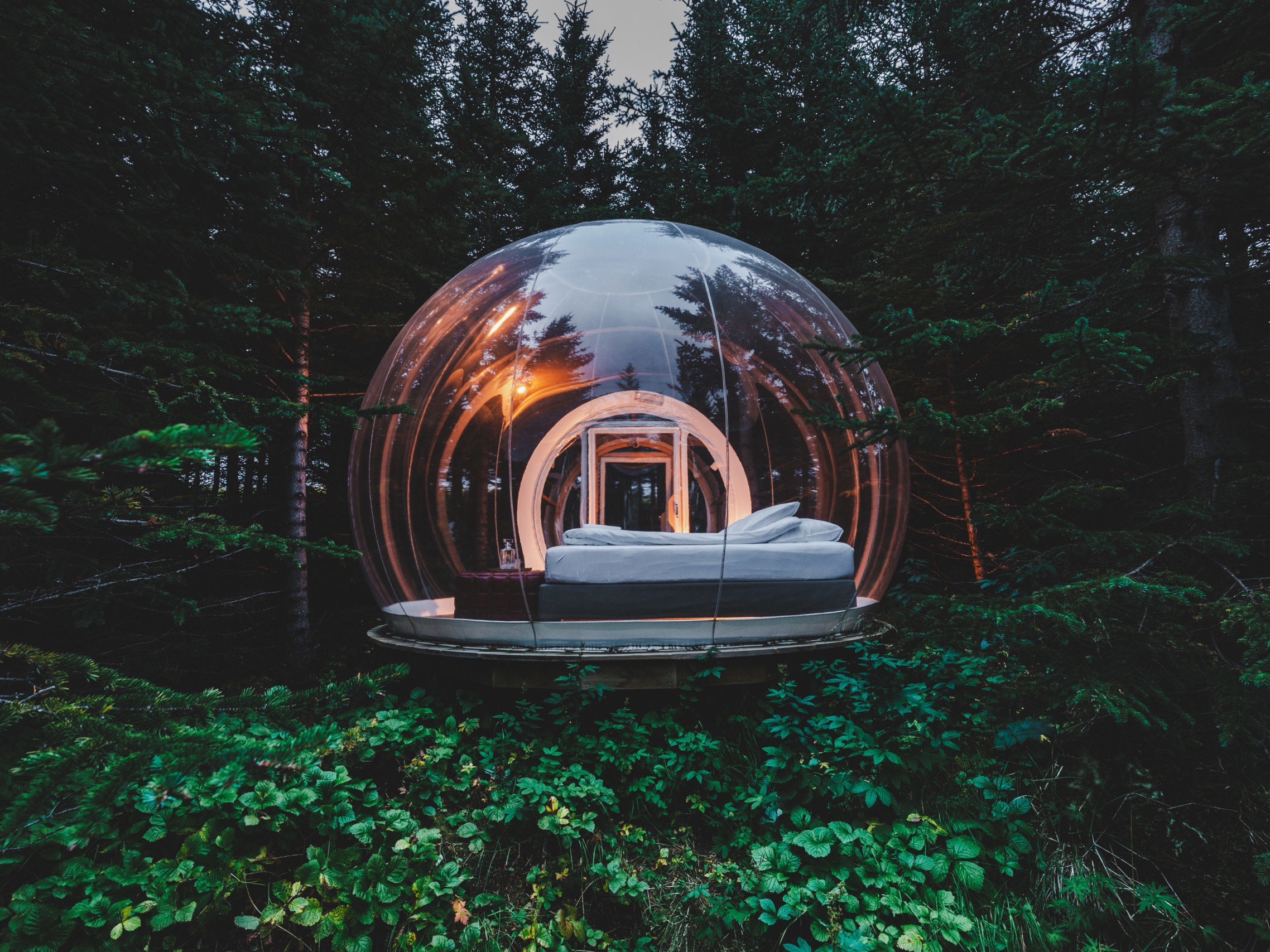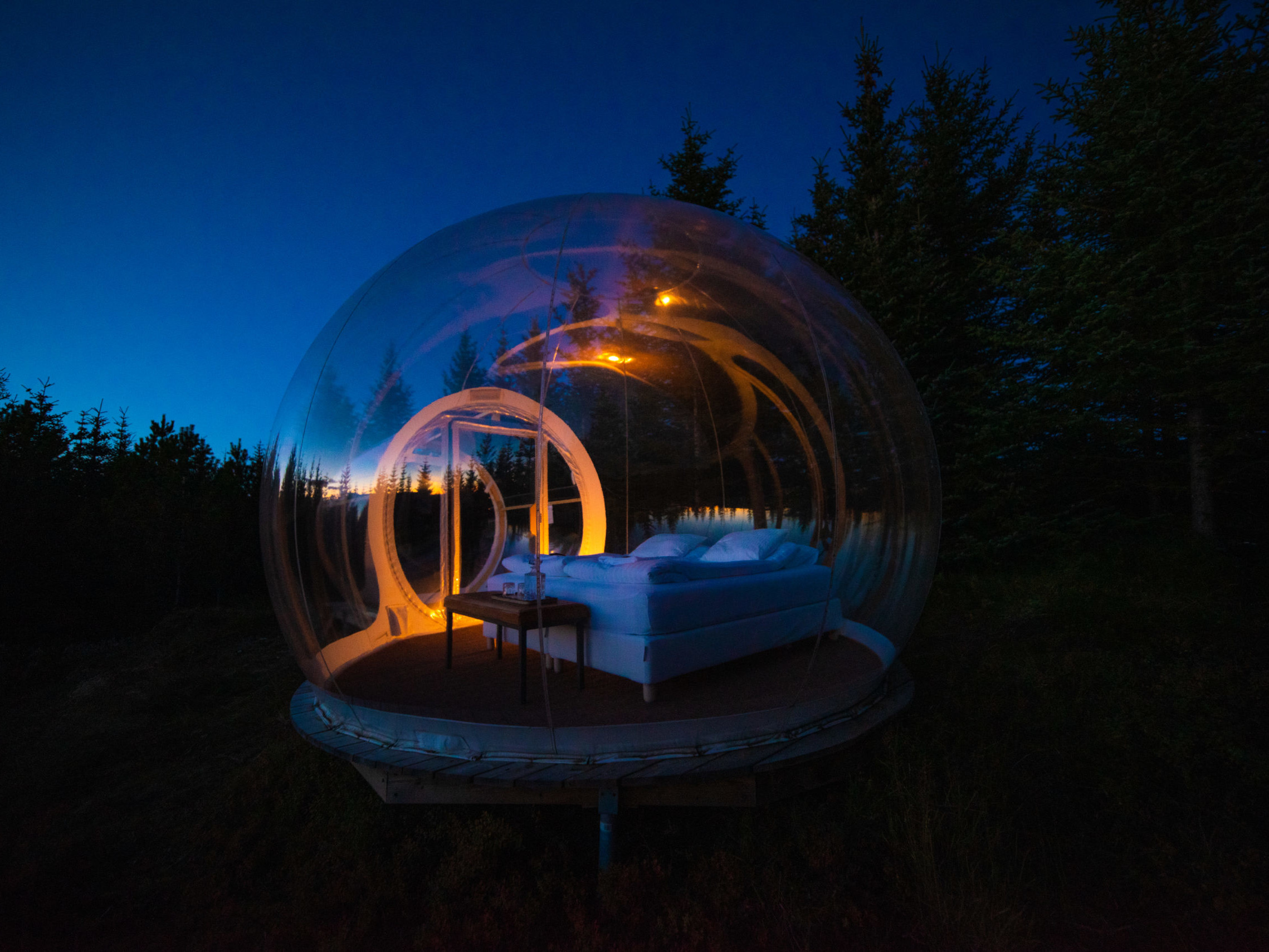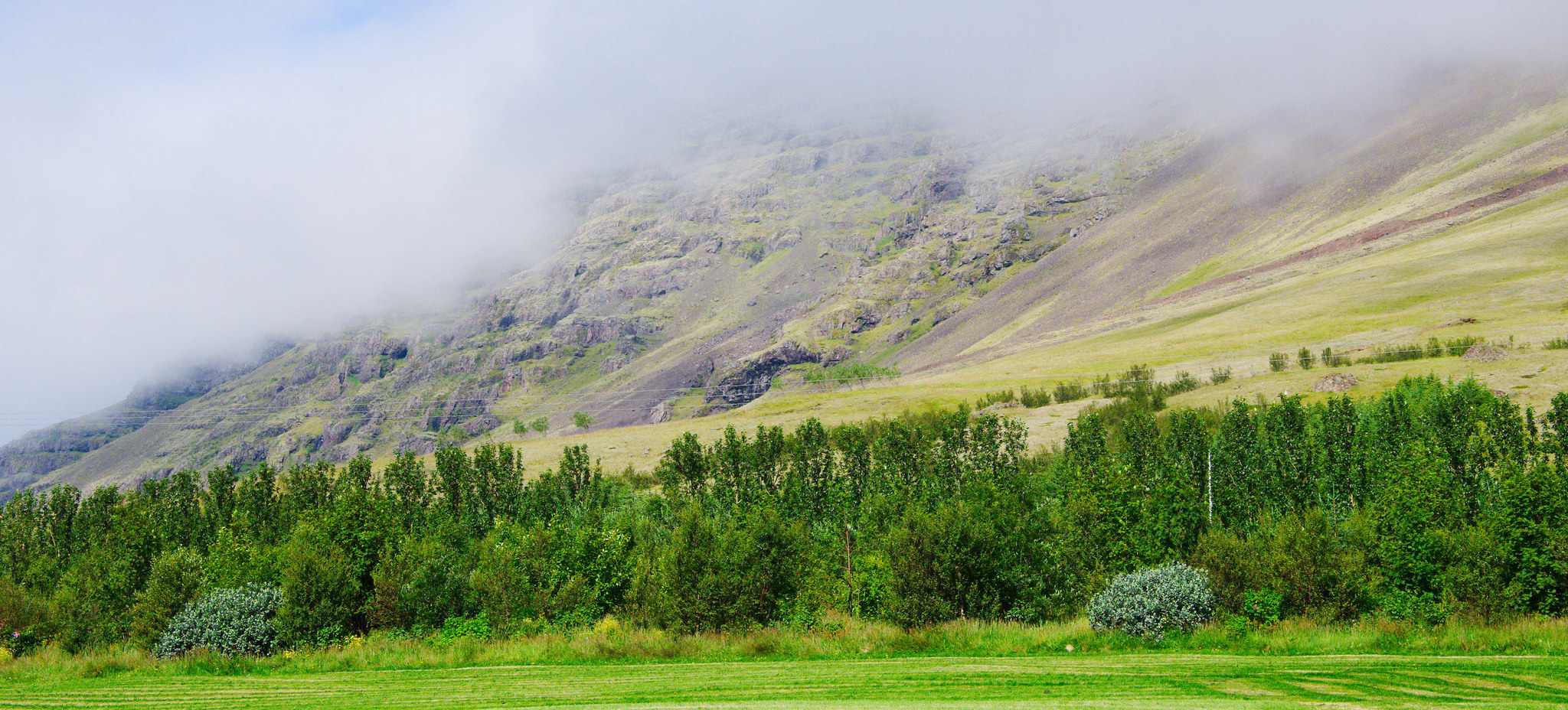Gender Pay Gap and Equal Pay in Iceland
Text by Sonia Nicolson
Gender Pay Gap and Equal Pay in Iceland
It’s now illegal to pay men more than women for similar work in Iceland or companies can face a gender pay gap fine.
Top of the World Economic Forum’s
Iceland has topped the World Economic Forum’s ranking for the 9th year as the nation with the smallest gender gap. However Iceland’s overall gender gap is now just 12%.
Closing the Gender Pay Gap
A new law was passed on International Woman’s Day 2017.
The aim is to close Iceland’s gender pay gap by 2022 and so a new law was introduced at the start of 2018 that asks public and private companies, with a staff of over 25 people, to pay employees equally. These companies are now are obliged to obtain government certification of their equal-pay policies or they could face financial penalties.
Employers must prove that they offer equal pay regardless of:
- Gender
- Ethnicity
- Sexuality
- Nationality
Iceland, the First Country to Legalise Equal Pay
Iceland is the first country in the world to legalise equal pay and is a world leader on gender equality. Though there has been legislation in place previously saying that pay should be equal for men and women but there is still a pay gap. Icelandic women earned, on average, 16% less than men (in 2016).
Global Gender Gap
Though other countries such as Switzerland and the US state of Minnesota have similar schemes in place with an “equal-salary certificate policies”, Iceland is the first to make equal pay compulsory for both private and public firms with a staff of 25 people. The bill was supported by Iceland’s centre-right administration, as well as its opposition. According the the Global Gender gap Index 2017, World Economic Forum, the global average annual earnings were $12K for females and $21K for males (in 2017), a huge gap.
“The legislation is basically a mechanism that companies and organisations… evaluate every job that’s being done, and then they get a certification after they confirm the process if they are paying men and women equally,” Dagny Osk Aradottir Pind, a board member of the Icelandic Women’s Rights Association, told Al Jazeera News.
Iceland is a relatively small country with a population of 323,000 people. It has a strong economy based on tourism and it’s fisheries.
Improving Equality for Women
Iceland has brought in measures to improve equality for women. One of these is a quotas on corporate boards and government committees. In 2016, female representation in the Icelandic parliament had reached a record of 48%, but this has since dropped. In December, a new Icelandic coalition government took office with left-green party leadership led by Katrín Jakobsdóttir. Known to be a feminist, she is the second woman to head a government in Iceland.
Despite an ongoing commitment to tackle this issue, Iceland’s gender pay gap has not shrunk fast enough.
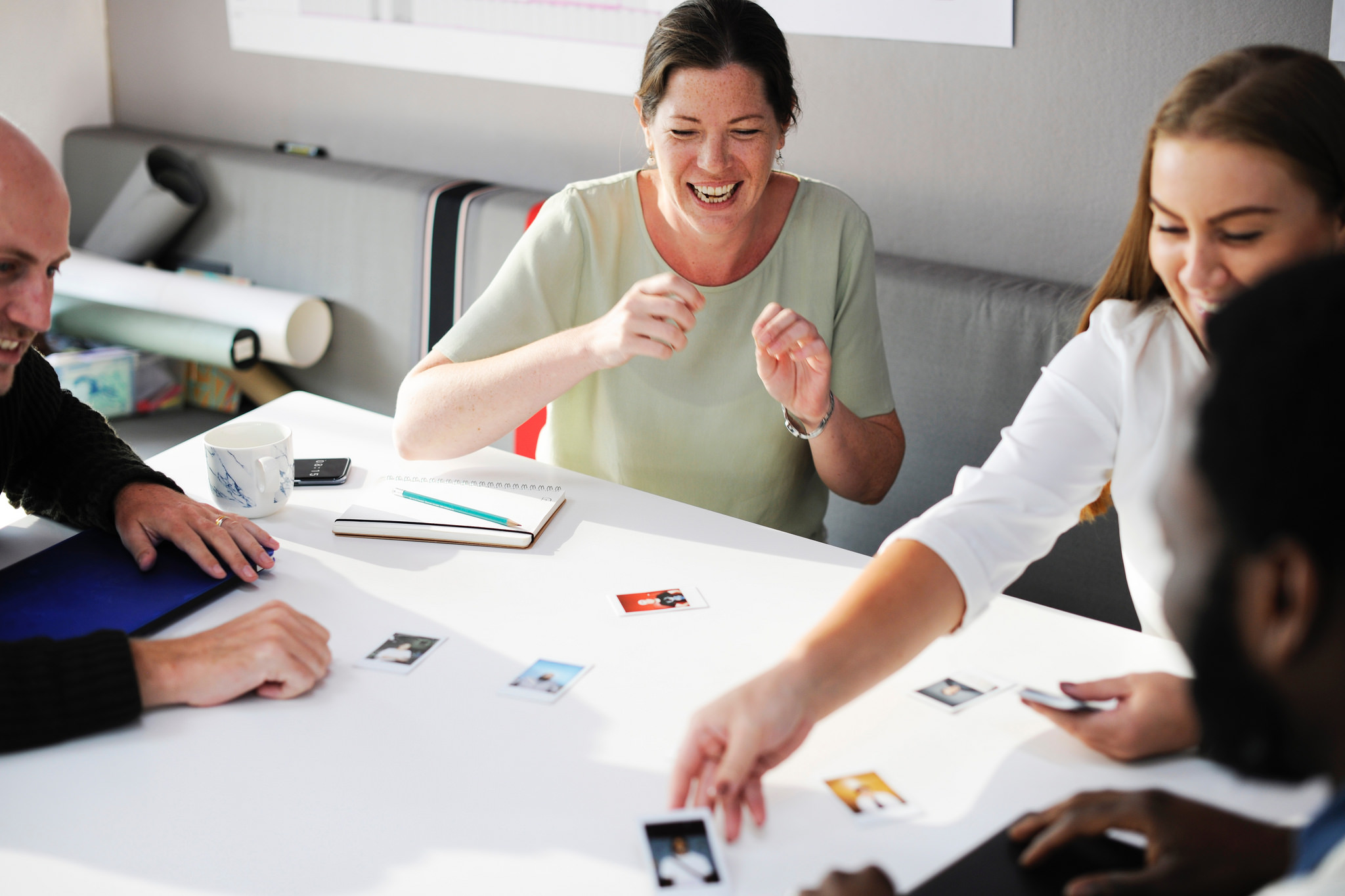
Photo by Perzon Seo
The Icelandic Women’s Protest
In October 2016, thousands of women across Iceland walked out of their workplaces at 2.38pm in protest. The pay discrepancy means that Icelandic women effectively work without pay after this time, according to unions and women’s organisations. Two years later and Iceland is talking this seriously and making its statement to the world.
Men Are Still Being Paid More
At a time when it appears that other countries around the world are stalling on economic gender parity, Iceland is committed to working on closing its gender pay gap by 2022. For now however, men are still being paid much more than women and, in addition to this, mens wages are increasing rapidly meaning it will be more challenging to meet the 2022 aim (according to the World Economic Forums wide-reaching Global Gender Gap Report, 2017). In Switzerland, women earn just 72% of the average male salary for similar work.
“The time is right to do something radical about the issue Equal rights are human rights” says Thorsteinn Viglundsson, Iceland Equality and Social Affairs Minister

Photo by WOCinTech Chat
Global Gender Gap Report
The Global Gender Gap Report looks at the differences between men and women in four key areas:
- Health
- Economics
- Politics
- Education
Although much progress has been made over the past decade, this report found that the gender gap widened for the first time in 2017 since records began in 2006.
Iceland has been one of the fastest-improving countries in the world over a 10year period according to the Global Gender Gap Report which uses markers such as economic opportunity, political empowerment, and health to measure gender equality in the country.
What’s the gender gap like in your country?
When Is The Best Time To Visit Iceland?
Text by Sonia Nicolson
When’s The Best Time To Visit Iceland, Summer or Winter?
First off, of course you can travel to Iceland all year round as there really isn’t a high season anymore, but one of the main questions we get asked is wether to visit Iceland in the summer or winter. Weather is a big factor in planning a trip to Iceland. The weather here is incredibly unpredictable and it is commonly said that “if you don’t like the weather, wait 5 minutes”. You can often experience both summer and winter weather in one day, and in any season, so it’s advised to expect the worst and hope for the best.
Many travellers come to Iceland in summer as they feel winter will be too challenging but winter is slowly becoming as popular so which is better? It’s a hard question to answer as both seasons have a lot to offer, so instead of recommending one, here are a few highlights for each season to help can decide.
WINTER – A Winter Wonderland
Let’s start with winter (October – April), winter in Iceland is so different from the soft green mossy landscapes of summer (June – August). This otherworldly landscape is covered in a white blanket of snow with stark contrasting black lava pecking through. Both are beautiful and should be experienced if you are lucky enough to travel here more than once.
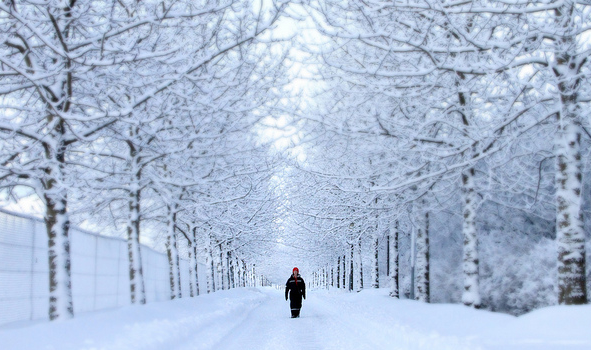
Snow, Sunsets and Frozen Waterfalls
In winter the days are short with sun rising at 10:45 and setting at 16:00. The sunsets are stunning with pink, yellow and orange glowing wisps across the afternoon sky. You will probably see some of the most incredible sites set with a wonderful wintery wonderland backdrop. Frozen waterfalls are just stunning but be careful as they can be very slippery and dangerous. If there is a ‘no access’ sign, please respect this as it’s there for your own protection.
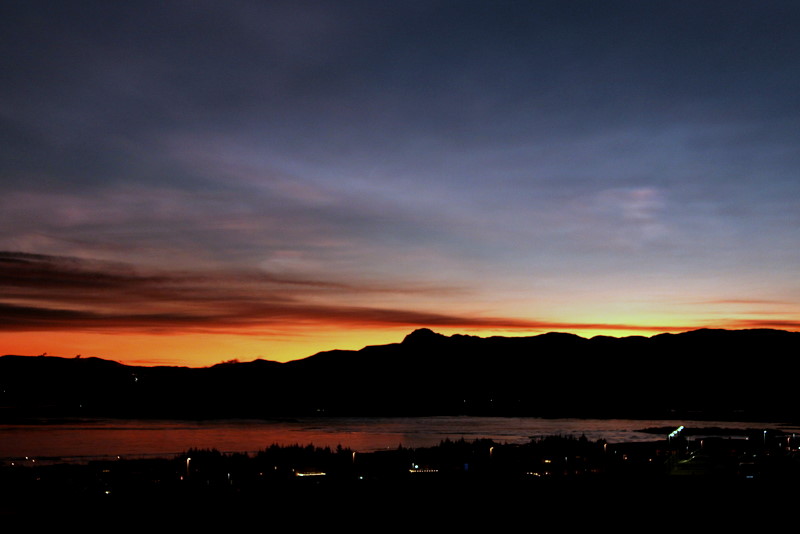
Northern Lights
The first and more obvious reason to visit in the winter months is for the Northern Lights. This breathtaking natural phenomenon can only be seen in winter, when it’s dark and the sky is clear. The rule is that if you can see the stars then you will have a good chance of seeing the Northern Lights. The best time to see the Aurora is from 1st September, through winter, until 15th April. Make sure to check the Aurora forecast for activity levels, there is a scale of 0-9 with the most common activity is 3-4.

Things To Do
There is plenty to see and do in Iceland, popular winter activities include glaciers hikes, skiing, snow mobile trips, ice fishing and ice cave exploring and winter is when the caves are the most accessible. Many people visit Iceland in the run up to Christmas and to celebrate New Years. People decorate their houses with fairy lights and these are kept on throughout winter, bringing an extra light and magic to the city. There is a small festive market and ice skating rink in downtown Reykjavik too. New Year in Reykjavik is an extraordinary experience with fireworks exploring all around. There are no official firework displays but many locals purchase them and have their own displays. The proceeds from the sale of these fireworks goes towards supporting the Icelandic Search and Rescue teams.
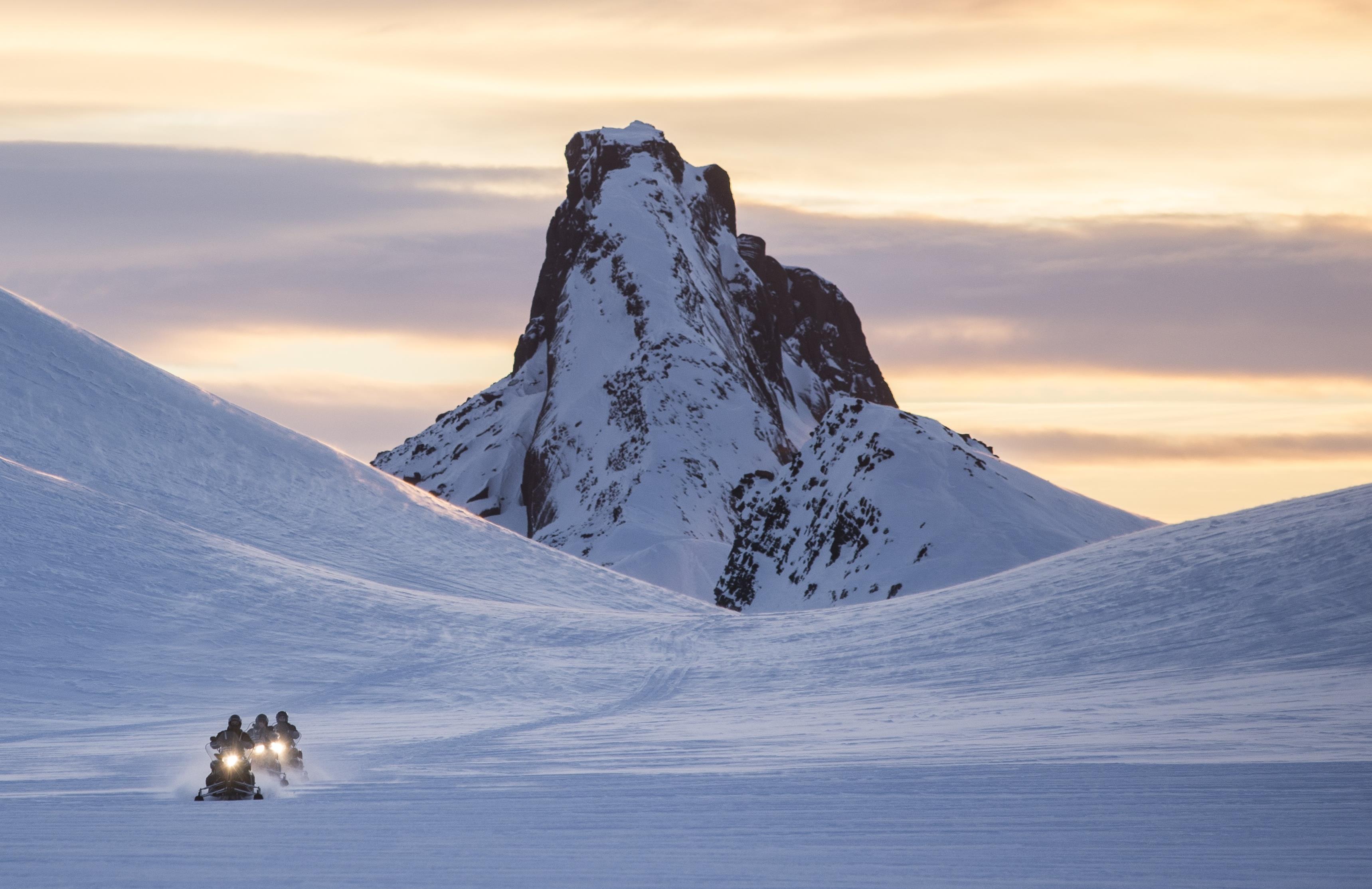
Driving in Winter
Driving in winter can be a little tricky, especially if you are not used to wintery conditions but all hire cars have winter tires to aid in driving on snow and ice. Snow storms are very common in winter and so your journey may be interrupted. The weather can effect airline travel with some flights being delays or cancelled so keep an eye on your flight prior to travel. Also sections of the ring road around Iceland can be effected with road closures throughout winter so it is best to check Vegagerdin for road updates. http://www.road.is/
The downside to visiting Iceland in the winter is that the days are shorter so your sightseeing time is a lot more limited. However the light, though sparse, is beautiful for photography as the sun is low on the horizon so it looks similar to a day-long sunset.
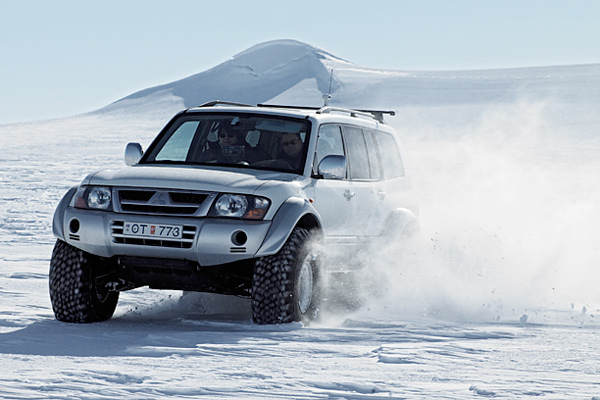
Wildlife
Though Iceland isn’t know as a wildlife destination, you can see birds, Icelandic horses and if you are very lucky you might also spot an arctic fox.
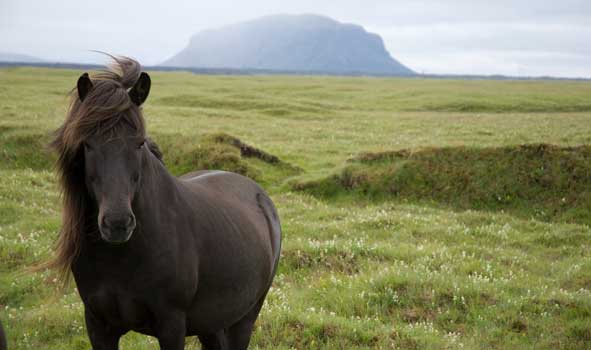
SUMMER – The Midnight Sun
Preferred by the locals, summer provides mild weather and the famous long summer nights. The days are long with sun rising at 03:20 and setting at 23:30 so you will have more light for longer adventures. This can be fun and the endless daylight can merge days into one but it can also be difficult to sleep. Come prepared with a good eye mask and be aware of the time, try to take rests when driving. Obviously the lack of darkness means you wont see the Northern Lights so make sure you plan for the right month to visit.
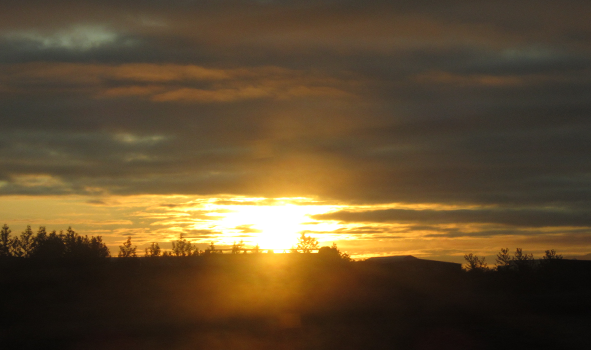
Waterfalls and Hiking Trails
Most sites are generally more accessible so you can walk right up to, and sometimes behind, the waterfalls. There are some hiking trails which can be accessed all year round but you will have more to choose from in the summer months.
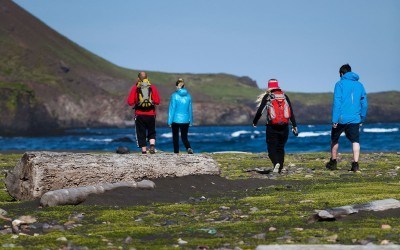
Budget Considerations
If you are travelling on a budget then summer might be more for you. Camping is easier and certainly more pleasant, and hitch hiking is much more common.
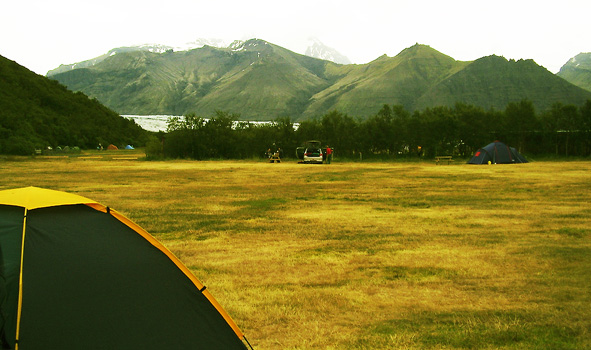
Moss and Lava
The icy blanket of snow melts away to reveal a green and lush mossy blanket over the lava fields. Road become easier to drive and are generally more accessible, with some of the highland roads being opened though it’s never advised to drive off-road. The northern part of the island is much more accessible now.
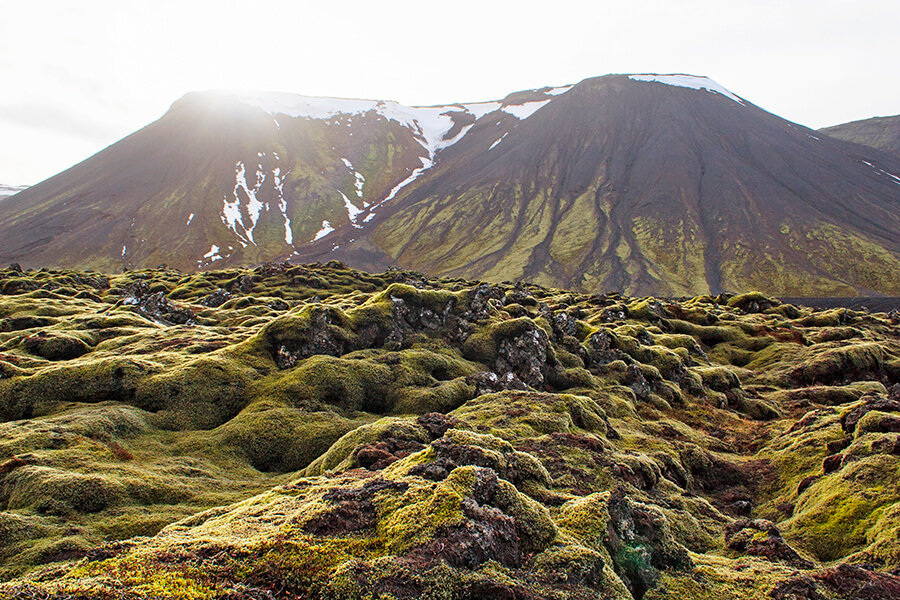
Wildlife
Though Iceland isn’t know as a wildlife destination, you can take a whale watching tour in any season, see Icelandic horses and often spot geese. Puffins are most commonly seen in summer along with other bird.
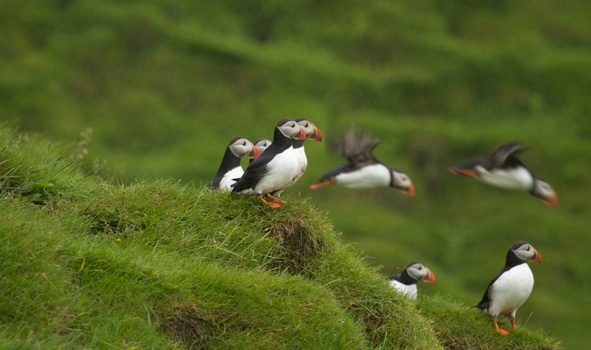
Regrowing the Icelandic Forests, Reducing Emissions
Text by Sonia Nicolson
Regrowing the Icelandic Forests
There is a particular lure to visiting this otherworldly island. Some describe the landscape as a ‘moonscape’ and last year alone 1.8 Million tourists visited. This dramatic landscape is a huge draw for the film and tourism industry but for Iceland, its barren land is problematic.
Iceland is one of the most deforested countries in Europe, technically 40% of the country is a ‘wet desert’. Before the Viking settlers arrived in the 9th Century, Iceland was almost entirely covered in trees. There is archeological evidence that a quarter of Iceland was covered in forests until these settlers arrived. Vikings, living in the Iron Age, chopped down forests for timber, farmland and grazing, removing these vital pillars from the ecosystem. Now Iceland is almost tree-less.
Vegetation struggles to gain a foothold so farming and grazing are near impossible in many parts of the country. Strong winds and sandstorms also destroy the land and this has been a problem for decades now, particularly the east of Reykjavik. But Iceland is committed to bringing its trees back and returning natural life to a largely barren landscape. The main reasons for regrowing its forests are to improve and stabilise soil, help agriculture and fight climate change as trees can help offset emissions.
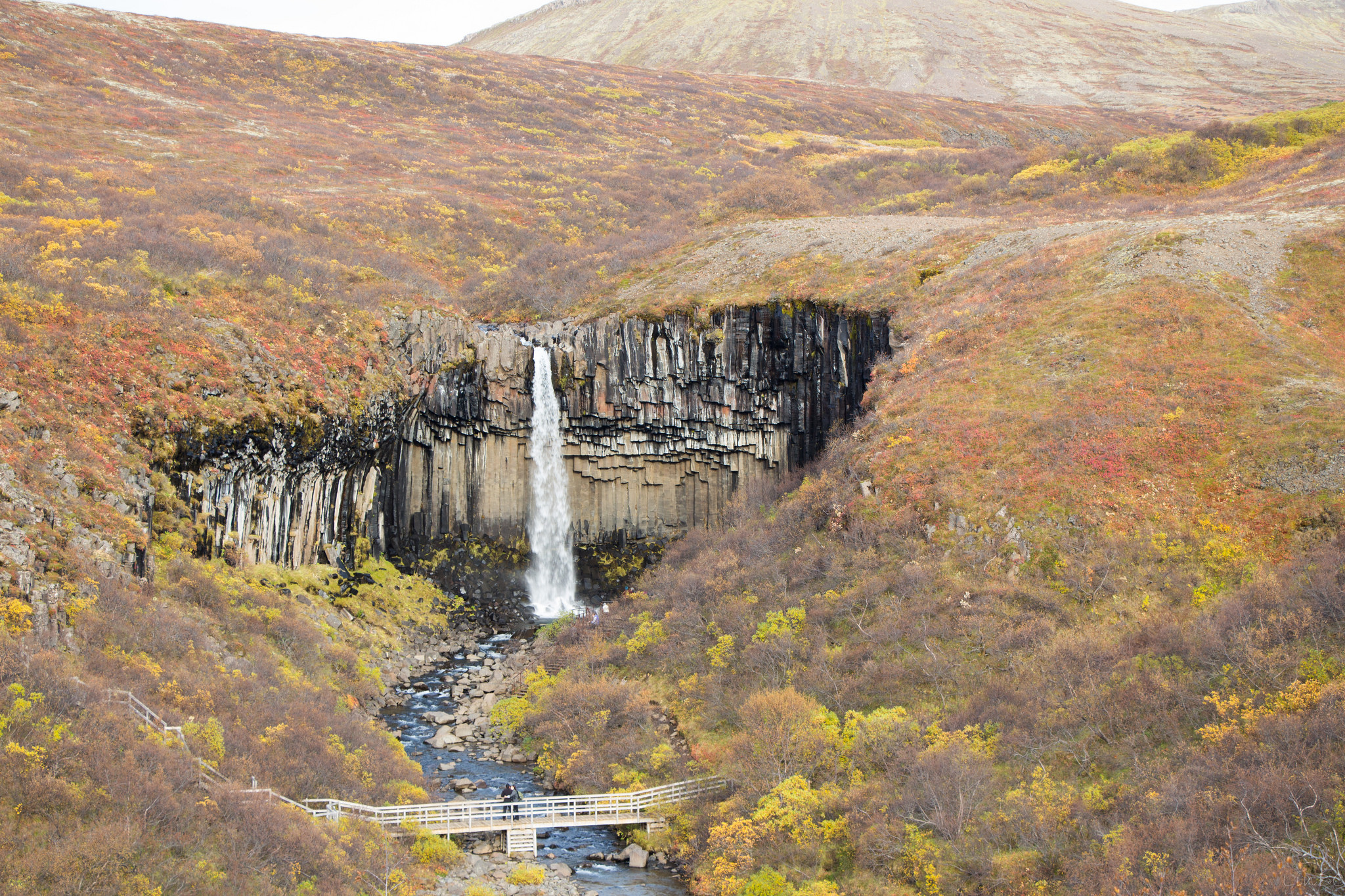
Taking Action
The government took medial actions and established a reforestation and soil conservation program at the turn of the century. First they started with conserving existing forests but in the 1950s and onwards, afforestation was seen as the only way. Reintroducing a small percentage of these trees could aid in Icelands aim to curb climate change emissions between 50% – 75% by 2050, the governments pledge in its Climate Change Statement, with less economic pain. Reinstating some of Icelands forests could help balance these emissions with the trees capturing carbon dioxide to help them grow.
Reforest sites are popping up across the countryside with native Birch and non-native Spruce being planted. These sites are overseen by the State backed Icelandic Forest Service who also manages the National Forests. Head of the Agency, Thröstur Eysteinsson, believes that even planting a small portion of Icelands long lost forests will do some good. “Over the past decades, the absence of vegetation to hold the soil caused farming and grazing to be nearly impossible in many parts of the country,”…“This was further compounded by the nation’s legendary strong winds, which contributed to severe soil erosion.”
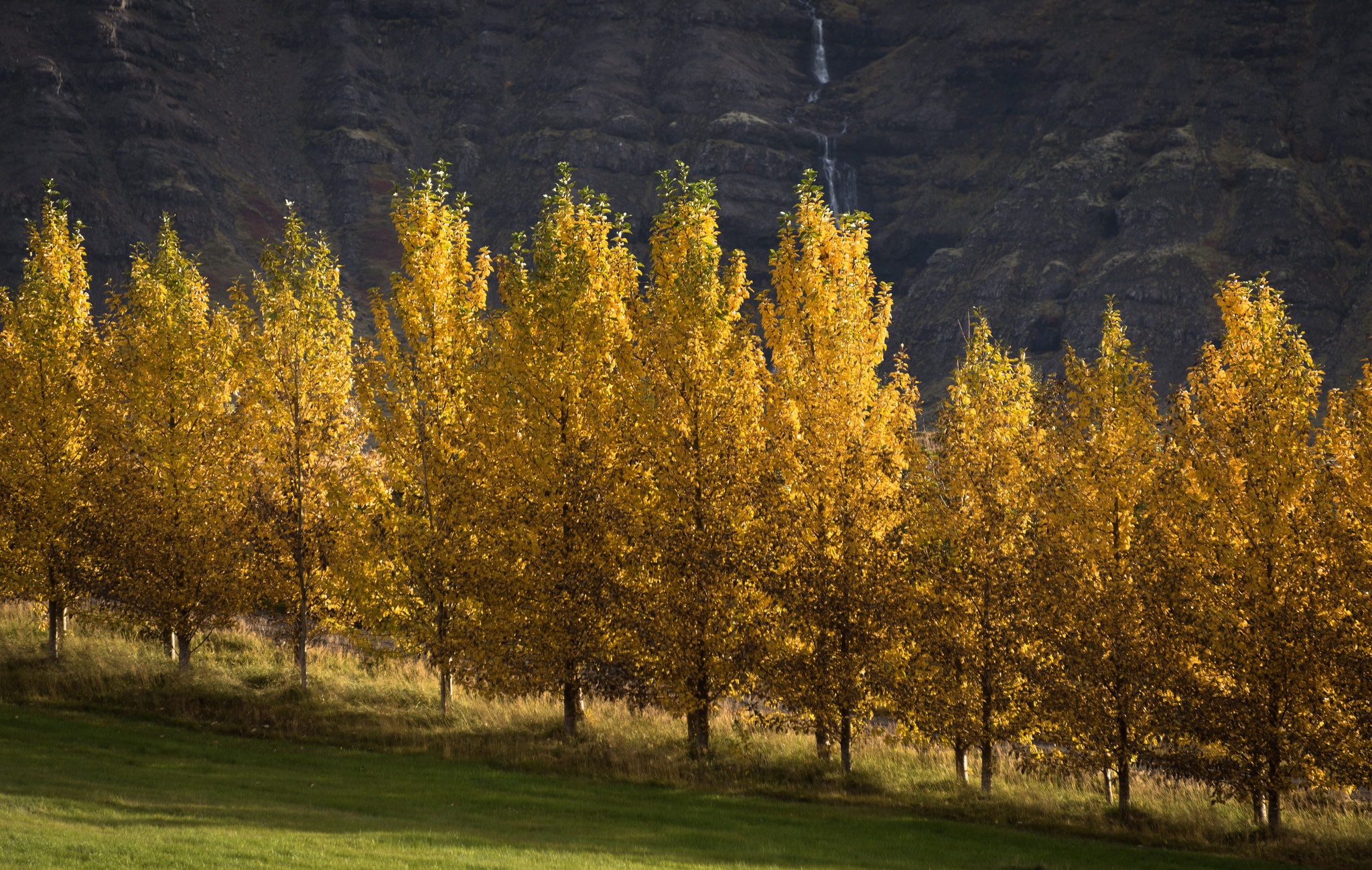
Icelands Energy
85% of Icelands energy is supplied from domestically produced renewable energy sources such as hydropower and thermal energy. According to the Icelandic and Northern Energy Portal, this is the highest share of renewable energy is any national total energy budget. However, Iceland has a high per-capita emissions of greenhouse gasses from transport and industry such as the aluminium smelting plant. Iceland could look into reducing its production and consumption but this would effect the economy, and changing a nations behaviour is very challenging i.e car sharing, taking public transport, etc.
The best investment is to plant trees as this is a financial investment and will eventually pay for itself, or even yield profit. Though it is a huge amount of work. Icelands climate is highly unpredictable and it varies each year which means slow, unpredictable growth for trees.
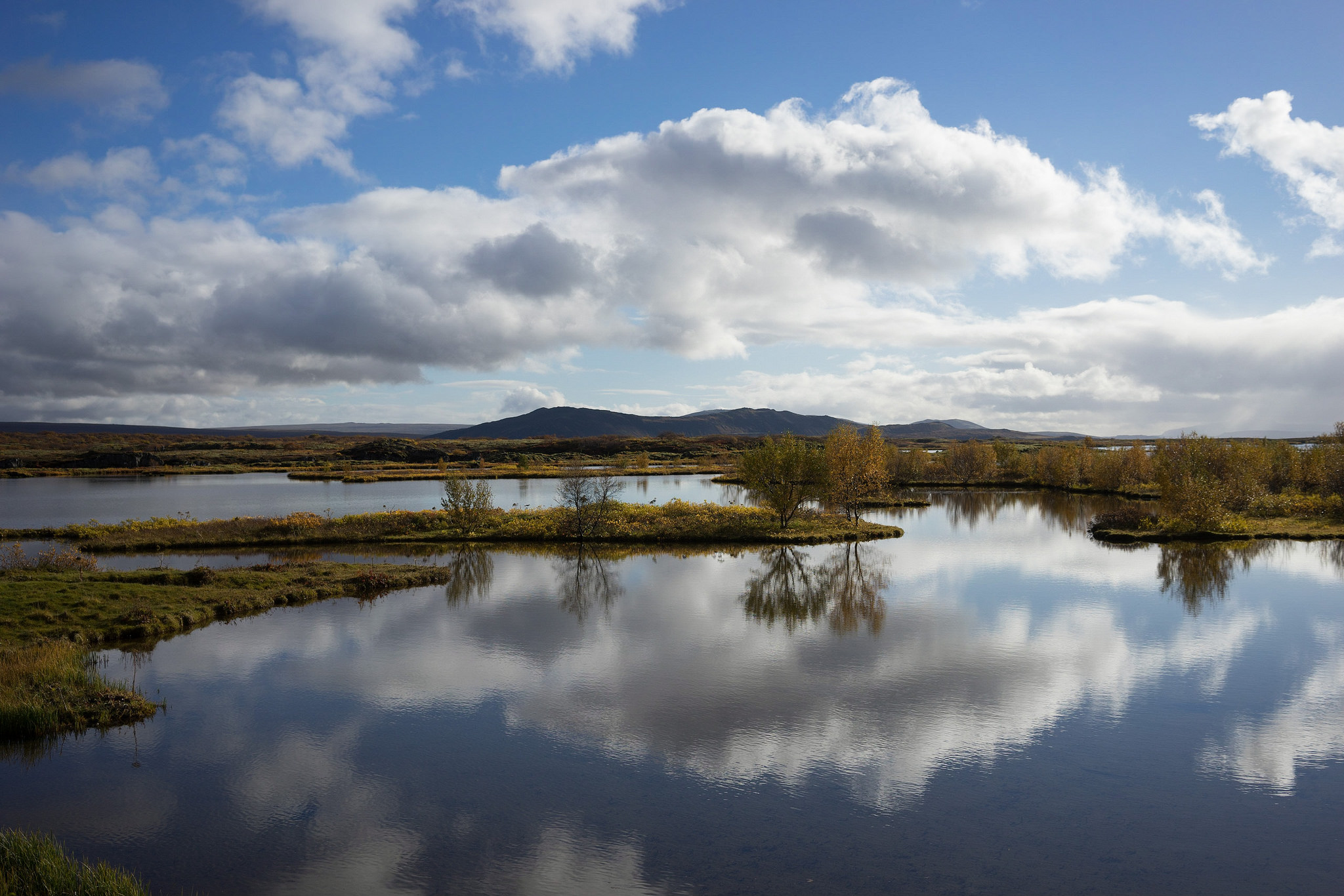
Regrowing the Forests
So Iceland is regrowing its forests but “it’s definitely a struggle,” said forester Mr. Jonsson who works for the private Icelandic Forestry Association and volunteers to plant saplings. They are growing around 3 Million new trees per year and restoring around 123,000 acres of long lost forests. It’s a slow and seemingly endless task. According to the Icelandic Forest Service, this is only around 2% of Iceland countryside.
Watch Our ‘Regrowing the Icelandic Forests’ Video
Preparing for the Trees
The process is to first evaluate the site and its existing vegetation to gain an understanding of the soils richness and help determine which trees to plant. Lyme grass is planted first which grows quickly and helps stabilise the soil. Lupine comes next, spreading across the landscape. Finally the trees are then planted, grown as saplings in local greenhouses first as importing live trees is prohibited in Iceland. Birch has been found to be best about 30% of the time, this links back to pre-settler times. It grows well in poor soil but slowly, everything grows slowly in Iceland and so meeting targets is challenging.
The sheep in Iceland roam freely and fencing is uncommon due to its cost. The sheep love saplings and so they need to be protected in order to grow and not have the natural spreading of trees interrupted. The goal is to replant 2.5% of Icelands forests but it has been said that this would take around 200 years at the rate they are going.
Funding has also been a challenge. The 2008 banking crash meant support was cut and, although the economy has since recovered, the pre-recession funding for 6 Million new trees did not.
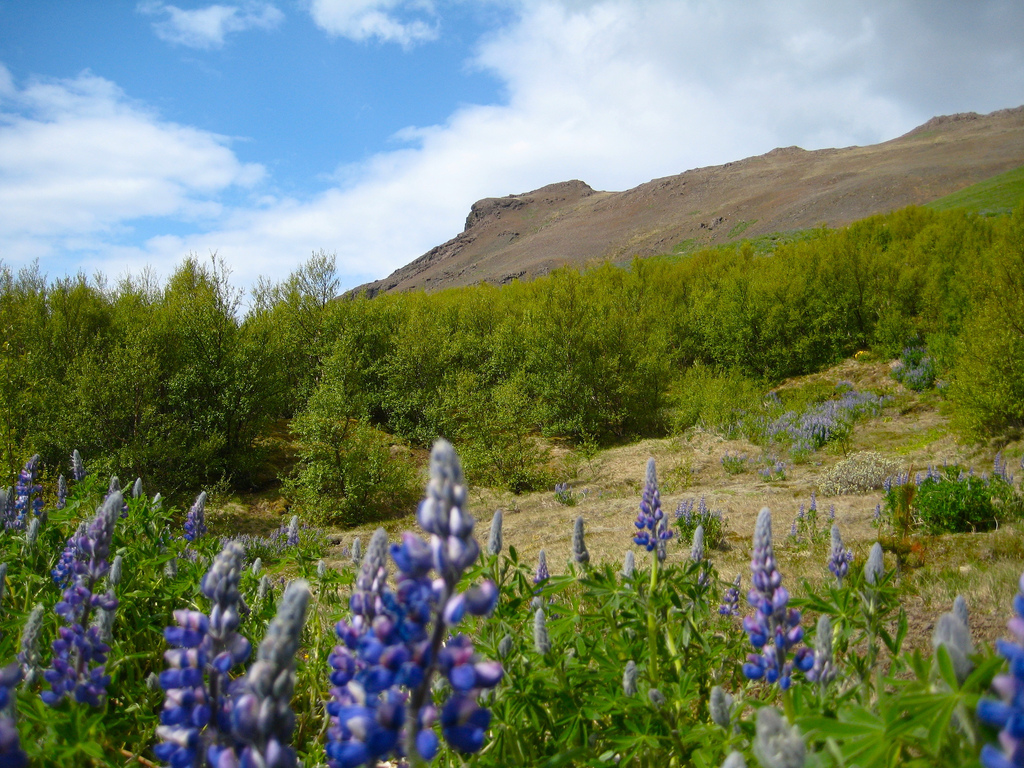
Footing the Bill, Meeting the Target
Iceland is a small country with a small population of 350,000 people per acre. This means fewer tax payers per acre. Forestry is just another item that has to compete with all the other worthwhile items people want to use tax money for. Therefore, sadly reforestation will continue to represent a very small part of the national budget.
Working with the European Union and Norway, Iceland is looking to reduce the emissions by 40% from its 1990 levels by 2050. Iceland might not grow 2% of its forests back but it could be a strong enough sign to other countries, and the international community, to show its solidarity and commitment to the climate change goals of the Paris Agreement.
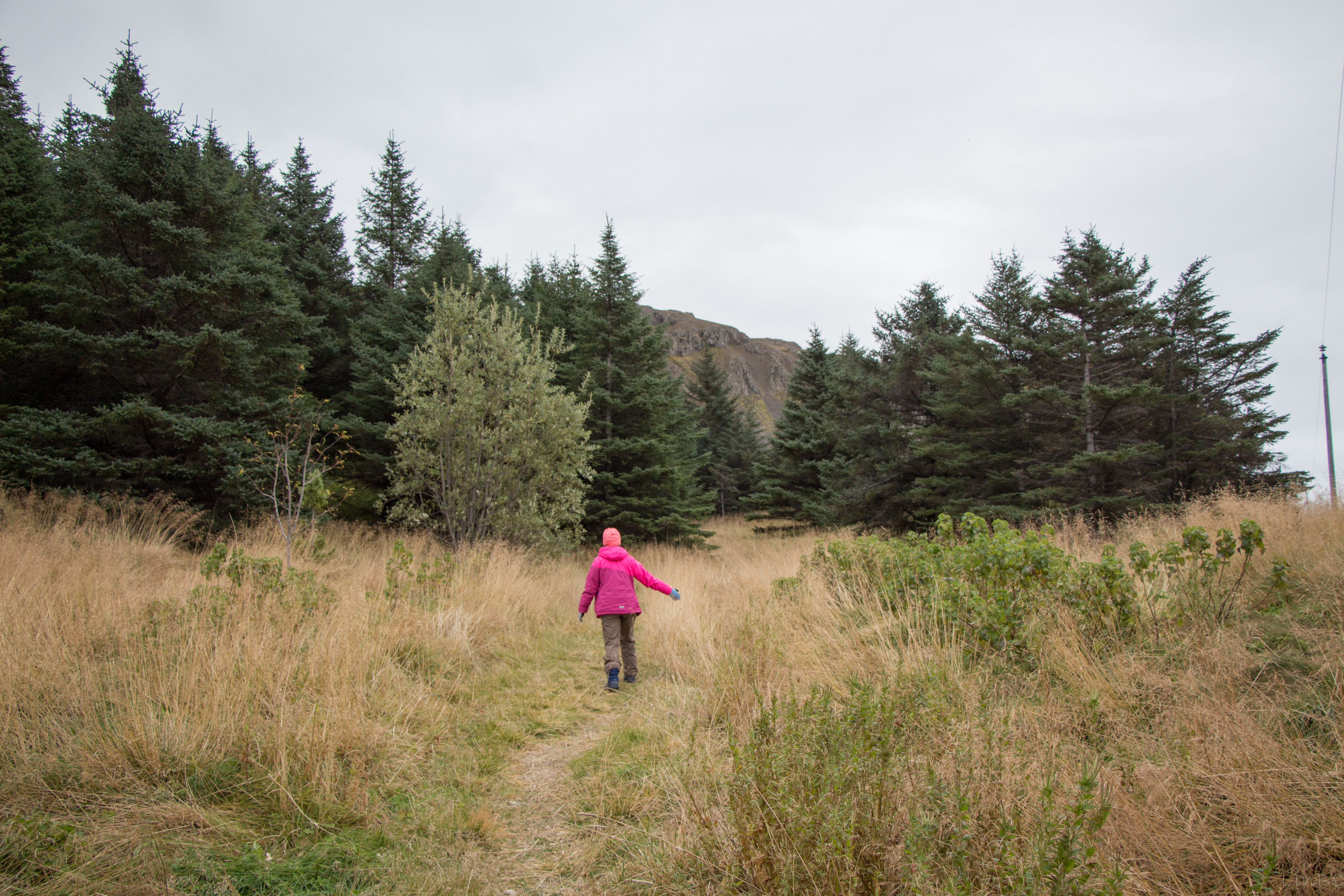
10 Pools To Try In Iceland
Text by Sonia Nicolson
Top 10 Pools In Iceland
A trip to Iceland isn’t complete without a trip or five to a hot pool, especially a natural geothermal one set in a beautiful landscape where you might be lucky enough to have it to yourself. There is a lot more to Iceland than the Blue Lagoon so today we are sharing ten pools to try in Iceland.
1. BLUE LAGOON
It’s the most obvious one so let’s start here. The Blue Lagoon is everything you have imagined it will be. It’s a truly relaxing experience and can be a very romantic one too. Located near Keflavik International Airport, it’s an ideal stop on your way to or from the airport. Recently extended in size with a new swim up bar and in-water massage area, the Blue Lagoon is a great welcome to Iceland. The distinctive blue hue of the water comes from that sulphur, so it’s a good idea to remove copper or silver jewellery before bathing as it can cause discolouring. Swim around in the calming blue waters, try out the waterfall, steams rooms, cave, algae and silica mud masks. Enjoy a refreshing drink at the swim up bar whilst your mask works its magic. With a rather large price tag and appearing on almost everyones bucket list, keep in mind that there are other options.
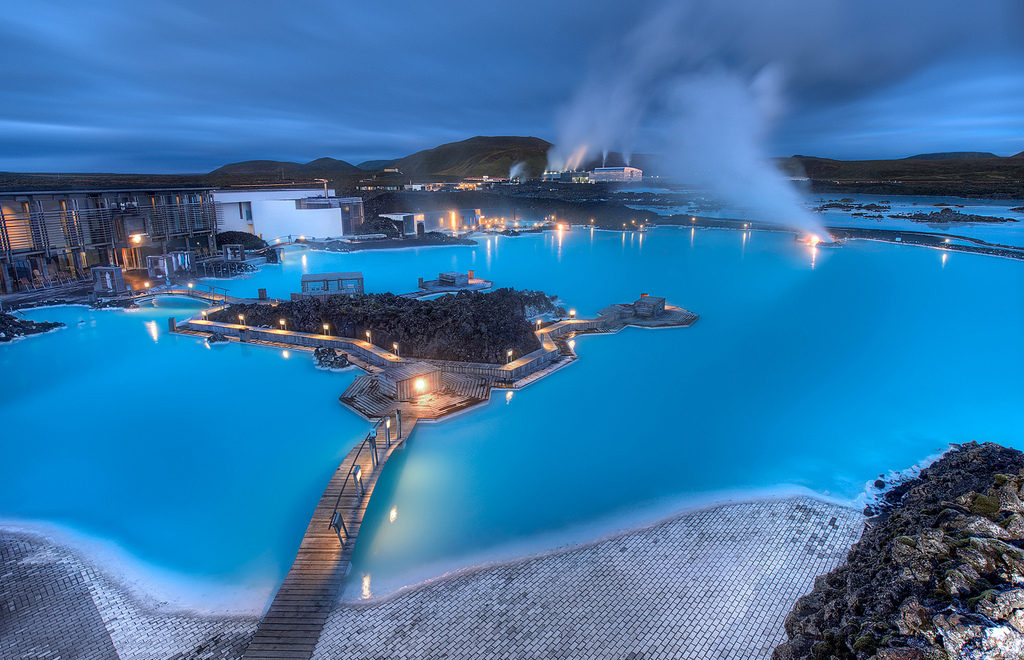
2. REYKJADALUR
Located an hours hike from the town of Hveragerði (45min drive from Reykjavik) is a hot river that welcomes you after a pretty stunning hike. The landscape is beautiful and changes from bubbling brown mud to green moss, steam billowing from the ground and rising from the algae filled waterfalls. Reykjadalur, meaning steaming valley, is the first of our completely natural (and free) recommendations. Once you arrive at the section popular for bathing, you’ll notice there are no changing huts. Strip down to your swimming costume and brave the few steps into the water. Access has been made easy by a manmade boardwalk with steps into the river. There are some screens to shelter behind and change but this is a pretty wild experience, especially if the weather is wild too, though it’s an unforgettable one. Walk or paddle upstream for hotter water, lie by the small damns and take in the view.
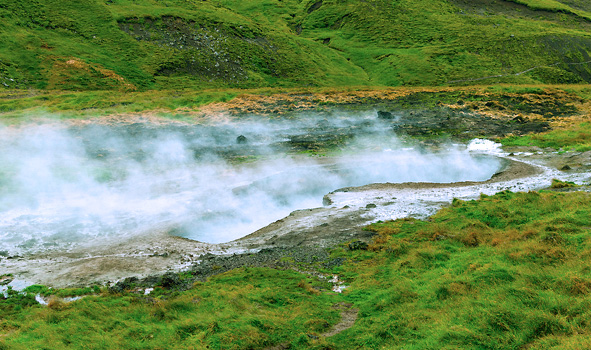
3. GAMLA LAUGIN / SECRET LAGOON
This pool is visited on our Golden Circle, Secret Lagoon & Bubble Tour and is a great introductory pool with easy access, changing facilities and showers. The Secret Lagoon is a unique natural hot spring, the oldest swimming pool in Iceland, built in 1891. It’s a large pool that was once used by local women to wash clothes in, and was the local swimming pool where children learnt to swim until 1947. The water holds at 38-40C (100-104 Fahrenheit) all year around. Here you can swim and float around, using the noodles provided, to find the hottest part of the lagoon. Once you are warm enough, take a short walk around the lagoon to see the beautiful landscape, original changing hut, natural geysirs heating the lagoon and the nearby greenhouse. There is a cafe here for a hot chocolate or snack afterwards.
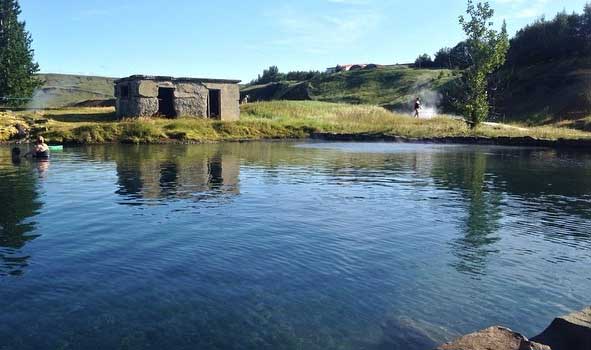
4. SELJAVALLAUG
Seljavallalaug is an algae pool located in a very dramatic setting at the base of the famous Eyjafjallajökull volcano. It’s relatively easy to find but is quickly changing from a local, secret pool to one being visited by tourists. Located on the south coast and just a short drive from Seljalansfoss waterfall. To access, drive up the farm road past Hotel Edinborg and park at the car park by the guest houses. Make your way up through the valley following the river path. It’s a short 15-20min walk on rocky terrain, crossing one waterfall, but is relatively easy and kids will manage. The pool is manmade and built into the rock face. There is a small but basic changing hut where you can change and leave your belongings. The pool is naturally heated but can be a little cooler if it has rained or snowed recently. The tap feeding the pool is located at the top of the pool, where everyone gathers but hot water also trickles down the rock face. The pool is an algae pool so can feel a little odd but is amazing for the skin. Lie back and enjoy the landscape, imagine the activity of the mighty Eyjafjallajökull and the history of this pool.
This pool is cleaned by volunteers annually and you can make a donation by the entrance to the changing hut. Please enjoy but be respectful of the pool and its landscape, leave no trace.

5. FONTANA
A manmade geothermal spa located near the Golden Circle. This is popular with tourists and can be a good alternative to the Blue Lagoon, though on a much smaller scale. Take in the healing powers of the geothermal springs with natural pools. If you are brave enough then take a dip in the refreshing lake. After you have enjoyed the spa, head to their geothermal bakery to try the Icelandic way of making pot-baked lava bread.
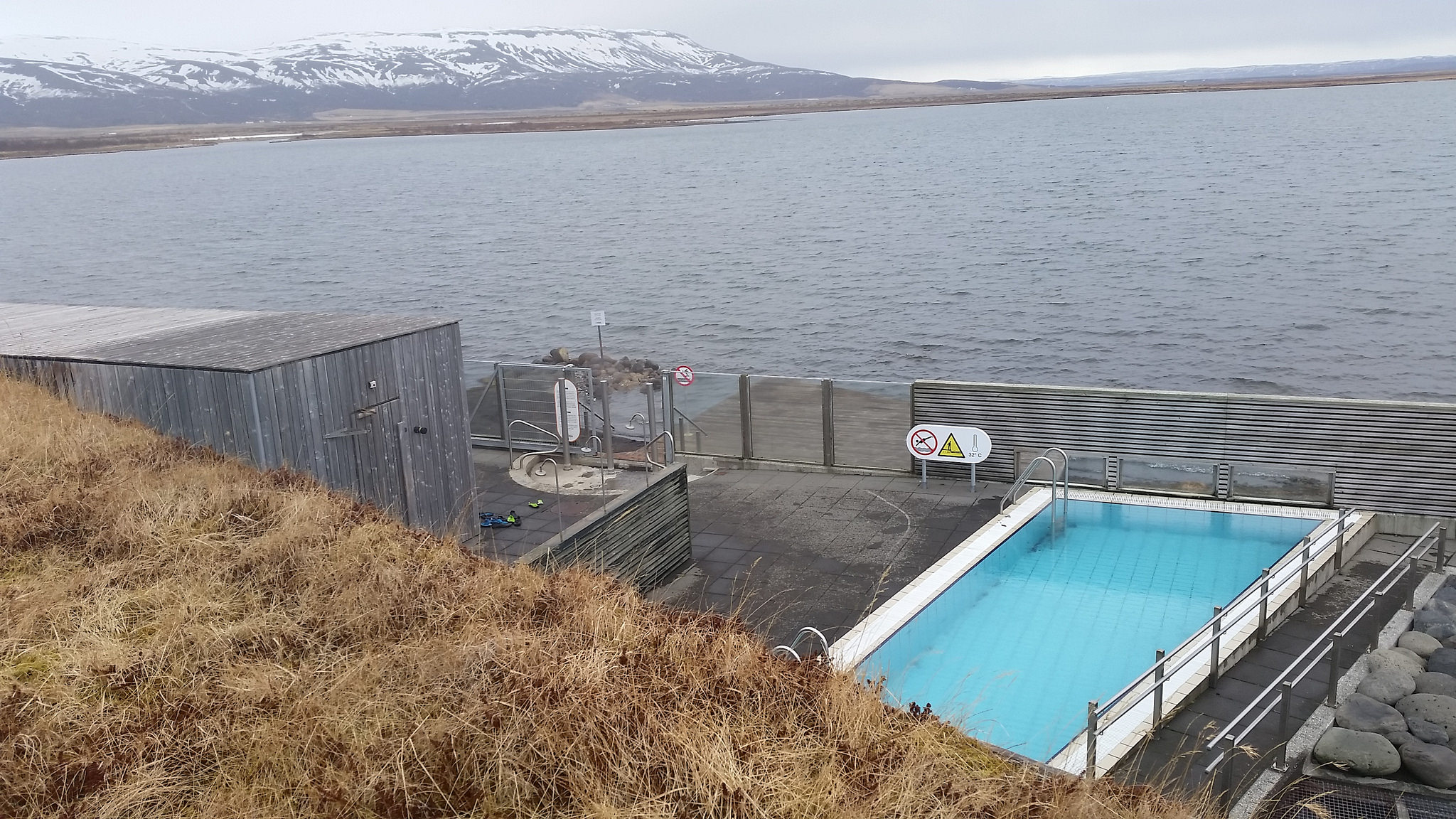
6. MÝVATN NATURE BATHS
The Blue Lagoon of the North, though a lot smaller, Myvatn was developed in 2004. Located on the sloped of Dalfjall, the baths have a beautiful backdrop of ochre coloured hills. Dalfjall is home to Icelands first geothermal power station. The milky blue colour of the water comes from 25 metres below you. The perfect place to enjoy a long hot soak in the 38-40 ̊C water or a seat in a sauna after hiking and travelling. There’s a cafe here too.
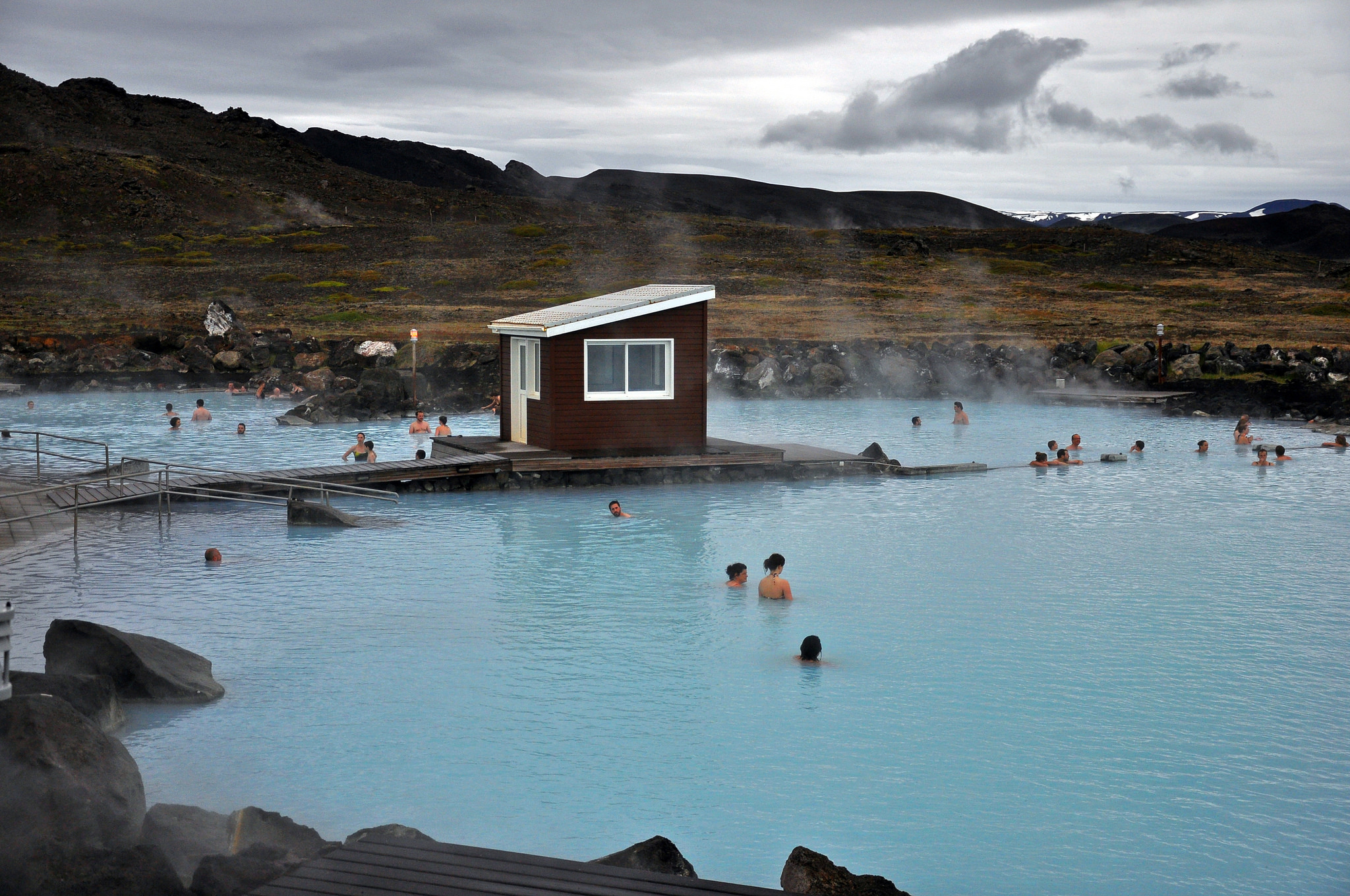
7. STÓRAGJÁ
Located at the bottom of a steaming lava fissure is a fairy tale hot spring. This is a very secret pool where the waters temperature is safe to bathe in but it’s often not recommended due to the algae growth. Make sure to read the signs as information is updated regularly. This is one for the more adventurous, bathe at your own risk.
8. GRETTISLAUG
Known in the Icelandic Sagas, this pool feel like its on the edge of the world. Grettislaug is located in the north of Iceland, on the coast. It is said that the famous Icelandic outlaw Grettir Ásmundason once swam 7km to the Icelandic shore from Drangey Island and regained his strength by bathing in the 42°C waters of this steamy pool.
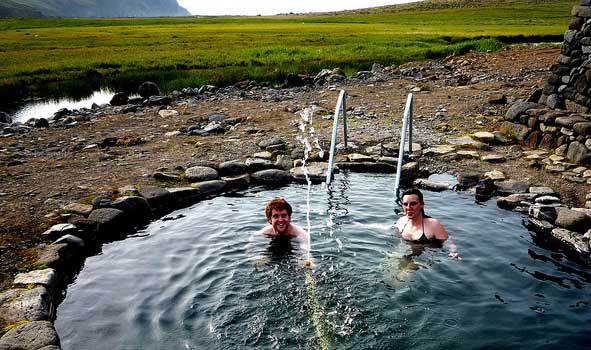
9. VITI
Viti, meaning hell in Icelandic, is a volcanic crater filled with milky blue water. Located in the eastern Icelandic highlands, this is a pretty wild place for a swim where the water fluctuates between 20-60°C. When the Askja volcano erupted it moulded the landscape, forming the carter and making it one of Icelands most dramatic landscapes. Only accessible by 4WD and so winter is out due to dangerous weather and road conditions. This is another one for the more adventurous but we do recommend taking a tour here or listening to an experienced local guide before accessing.
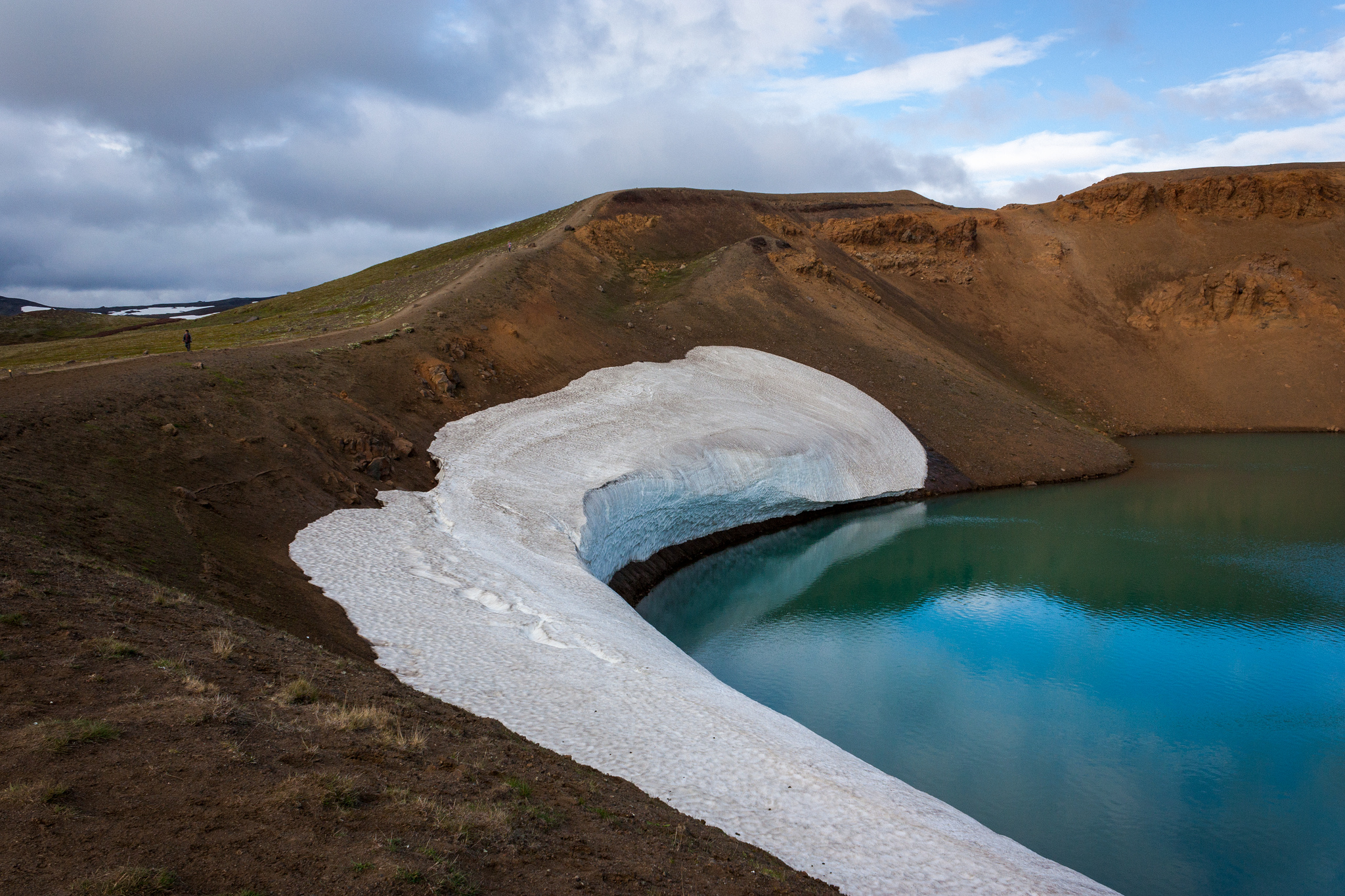
10. LANDMANNALAUR
Set in some of the most stunning and dramatic scenery Iceland has to offer, this geothermal bath is located in the highlands of Iceland. The landscape here changes with the movement of the sun, a truly unique place surrounded by over 500 year old lava fields and mountains of yellow, blue, white and orange. The water here is 36-40°C all year round. Stay in one of the local cabins or camp, and hike the many treks. You will need to join a tour or self drive a 4WD to get here, access in the winter can be very challenging.
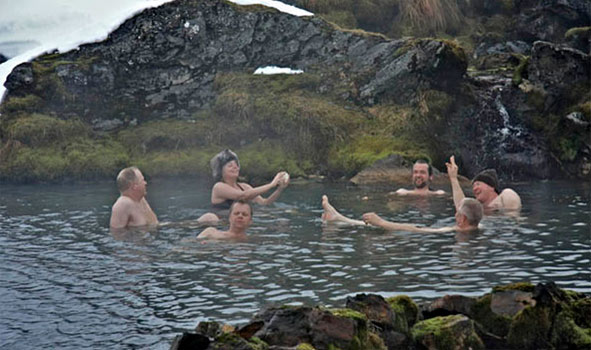
A Night in the Bubble
Text by Sonia Nicolson
A Night in the Bubble
Last week I had the chance to stay overnight in one of the Bubbles, so I took my Mum and we headed off for a night under the stars. A beautifully crisp winters day, we arrived into a winter wonderland, ready for the Aurora and to sleep under a blanket of stars.
Some childhood dreams stay with us our entire lives. Sleeping under the stars or watching the Aurora Borealis dance might be one of them. To fulfil these dreams, the Bubble concept was born. It’s the ultimate glamping experience and perfect for viewing the Northern Lights.
What are the Bubbles?
The Bubbles are a fully transparent, inflatable structure made out of fire-retardant PVC tarpaulin. Nestled in a small Icelandic wood they make for ideal Northern Lights viewing. Somethings referred to as the Bubble Hotel, these structures sleep two adults in a comfortable double bed. The bubble structure is kept inflated by a slight over-pressure from a noiseless ventilation system. It permanently renews the air inside 2-7 times the volume per hour and this way it prevents humidity. The system has heating elements with thermostat so the Bubble stays warm all winter.
Are the Bubbles all transparent?
Yes, although some offer a little more privacy with a white panel wrapping around the bottom of the walls at bed height. This however does not interfere with your view of the sky and you still feel like you are sleeping right in the woods.
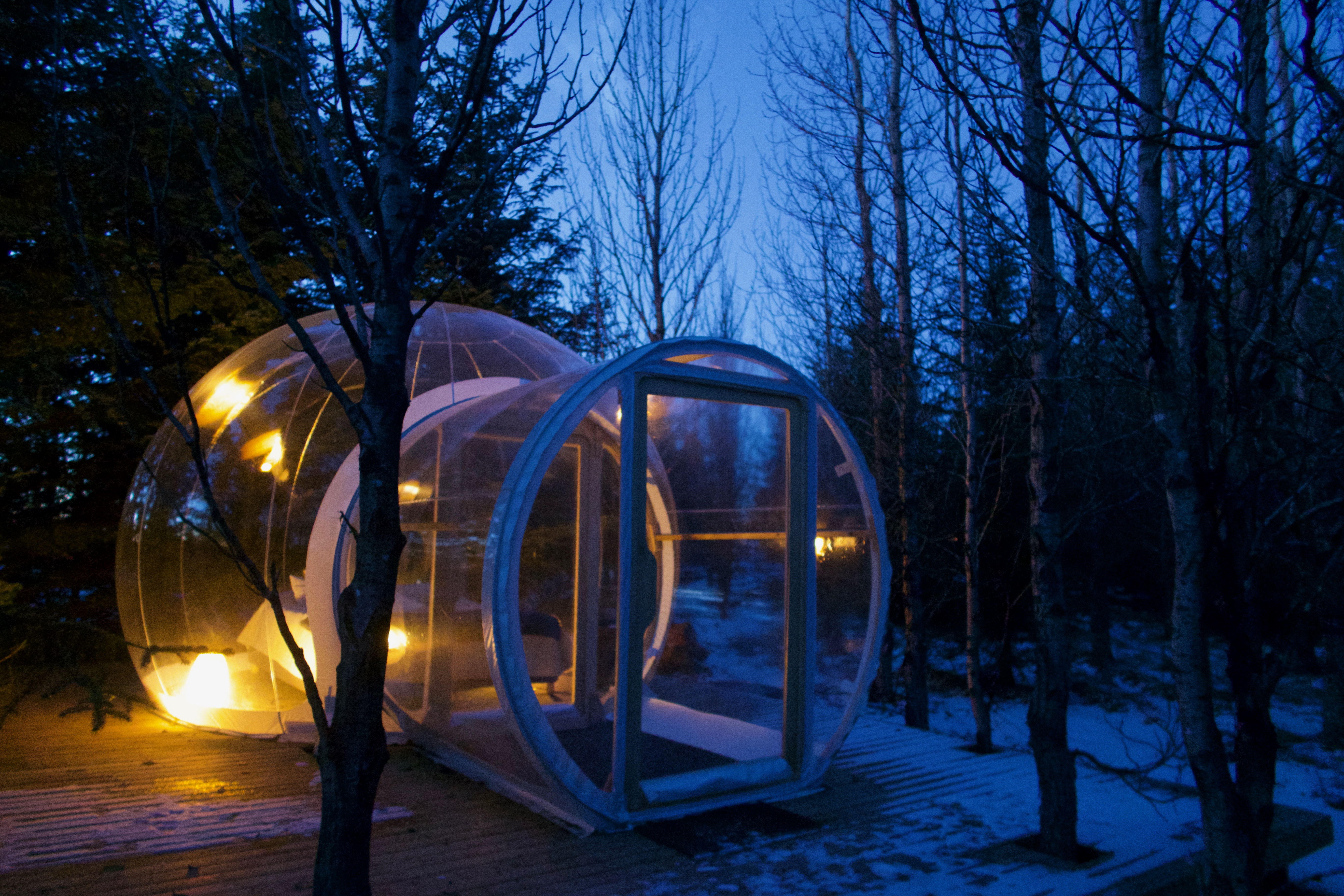
Where are the Bubbles?
The Bubbles are located in the countryside, near the Golden Circle, however the location is kept secret until you have booked. This secret location is around an hours drive from Reykjavik and two hours from Keflavik Airport. Set back from the road and surrounded by trees, the Bubbles are nestled in a beautiful spot where you can see volcanos Katla and Eyjafjallajökull on the horizon.

What is there to see?
The Bubbles are located in a very beautiful landscape which is picturesque, especially at sunrise. If the sky is clear of clouds then you will hopefully see a starry sky with some magical Northern Lights dancing above your head.
What is there to do?
Not a lot which is a good thing. This is an opportunity to truly chill out so lie back and take it all in. Nearby is the town of Fludir where you could take in the waters of the Secret Lagoon. This is a unique natural hot spring, the oldest swimming pool in Iceland (made in 1891). The water holds at 38-40 Celsius (100-104 Fahrenheit) all year around. Swim and float around, try to find the hottest part of the lagoon. You can also take a short walk around the lagoon to see the beautiful landscape, original changing hut, natural geysirs heating the lagoon and the nearby greenhouse.

Is food provided?
No, but you can store and prepare food and drinks in the service house. There is a fridge, kettle, coffee machine and a two-ring electric hob. There are plenty of dishes and a dish washer too.
Nearby is Minilik, an Ethiopian Restaurant which gets great reviews, and Mika, a family run restaurant specialising in handmade chocolates and langoustine dishes.
What should I bring?
Pack a small rucsac with you pyjamas, wash bag, camera (and tripod for Aurora shots), a good book and your swimming stuff for the Secret Lagoon. Wear good walking boots, a wind / waterproof coat, and layer up. You won’t need a towels or bedding, these are provided and the Bubble has extra blankets, electric blankets and a spare air heater so you will be cosy and warm. As the Bubbles are small, there isn’t enough room for a suitcase so leave that at your hotel or in a left luggage facility and just bring a small bag.
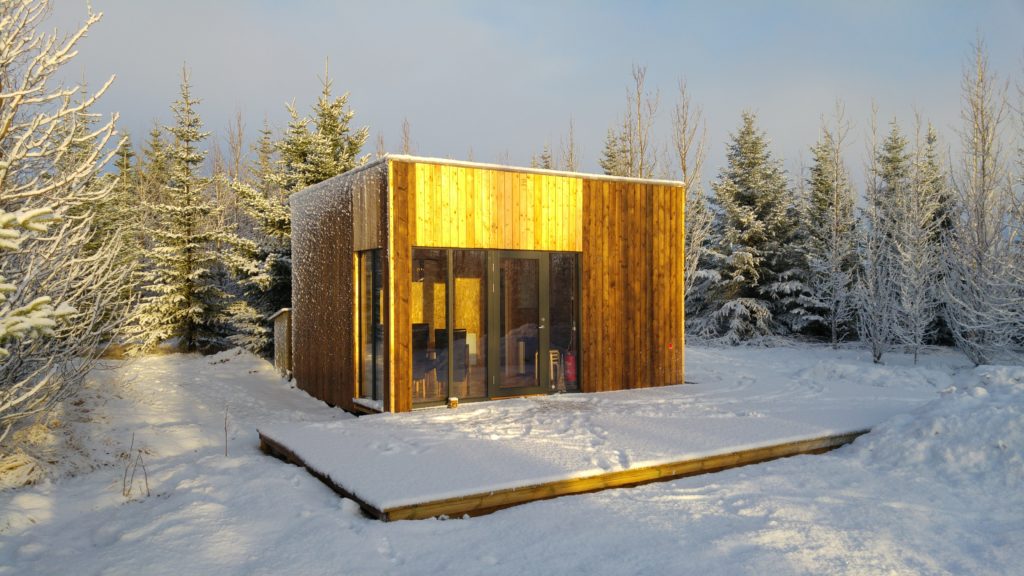
Where is the toilet?
The toilets are in the service house, a short walk from your Bubble. There are two shower rooms with sink and toilet. Towels are provided but bring your own for the Secret Lagoon.
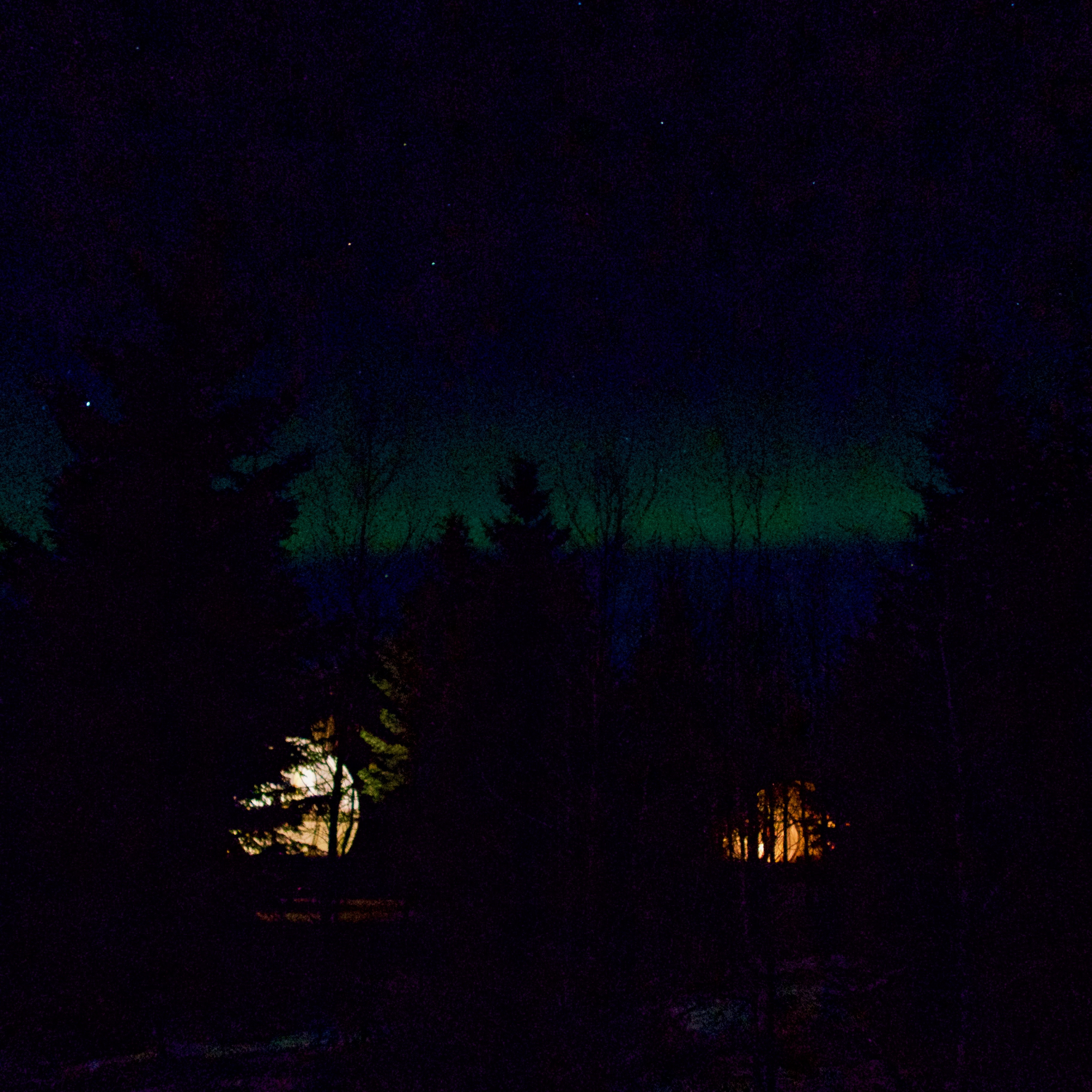
Can I stay without the tour?
The Bubbles are part of the tour on offer by Northern Lights Iceland so you cannot stay without booking the tour. Northern Lights Iceland is a travel agent and not a Hotel. The tour is fabulous and takes you in a luxury suburban jeep to the Golden Circle stopping at Geysir, Gulfoss and the Secret Lagoon. The tour group is small, maximum six people, and there are only nine Bubbles on the site so it feels very private.
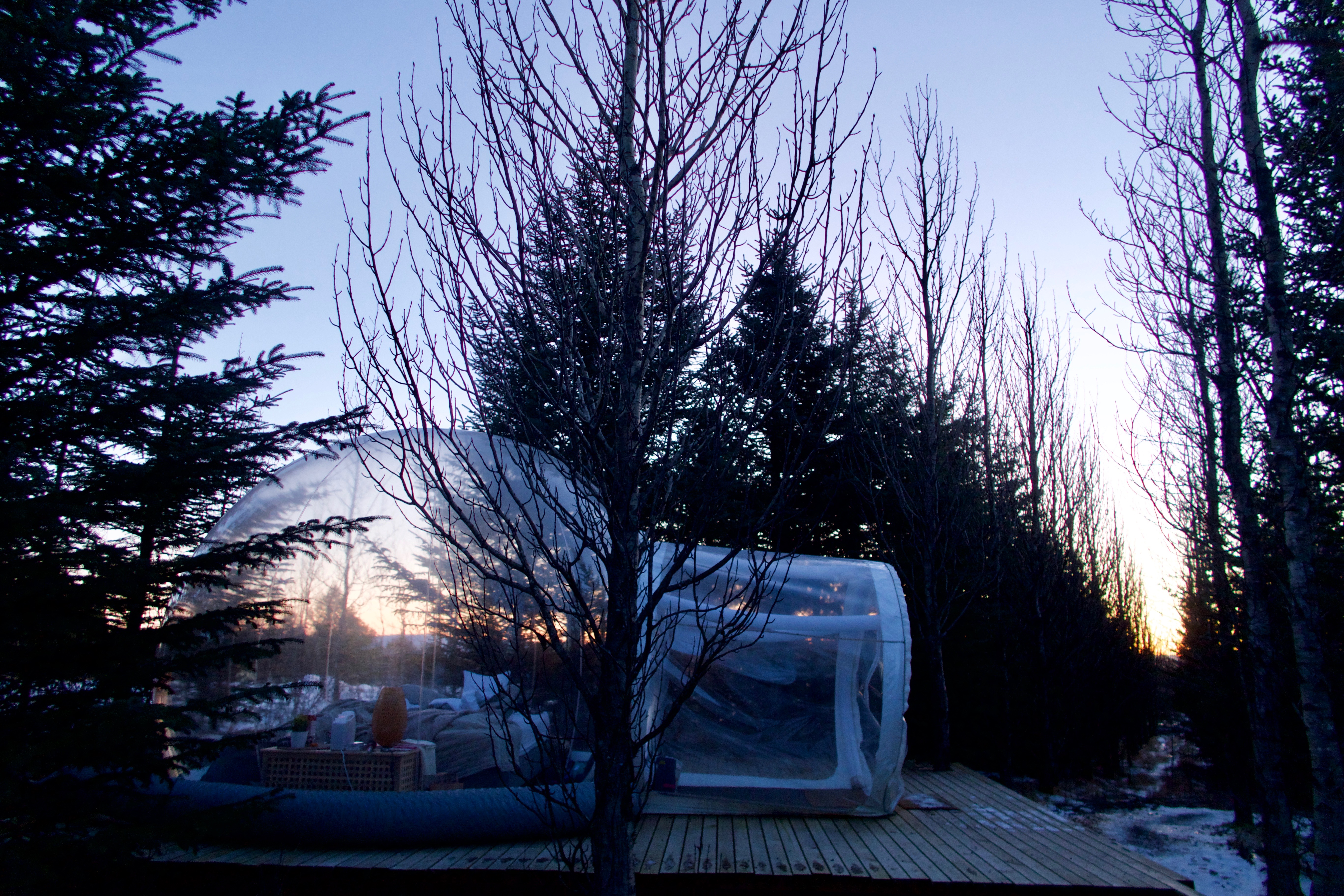
How much does it cost?
59,900ISK per person (use a currency convertor for USD or other currencies)
Please note, the minimum age is six years old, for health and safety reasons.
Where do I book?
Book your Bubble Tour here


